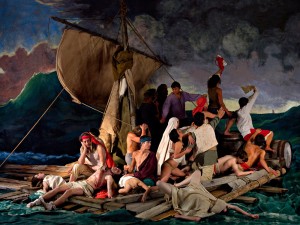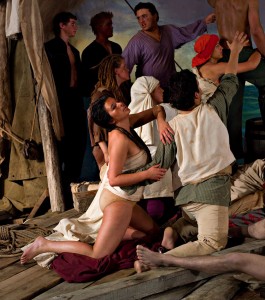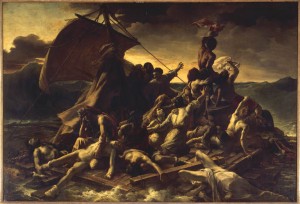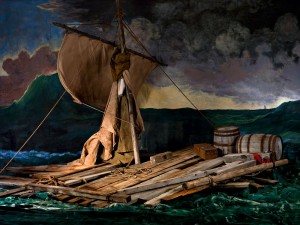I first came across the work of Adad Hannah at Montreal’s Museum of Contemporary Art’s inaugural triennial exhibition focusing on Quebec artists held over a year ago. Hannah’s photographs taken at the Prado Museum showed viewers (now subjects) engaged with the art in active ways: a woman leaned in to kiss a statue of Eros, two men looked into a mirror in front of Velasquez’s Las Meninas. In Las Meninas itself, a mirror at the back of the room has been interpreted in various ways in art historical literature, and Hannah’s layering of a second mirror once again questions the role of the viewer. With his most recent show, the New York-born Montreal-based artist continues to produce memorable and engaging works of art that thoughtfully and intelligently dialogue with the history of art. This time Hannah challenged Théodore Géricault’s Raft of the Medusa (1819).

In his small solo show, The Raft of the Medusa (100 Mile House), at Pierre-François Ouellette Art Contemporain (PFOAC), Adad Hannah has documented the recreation of Géricault’s Raft of the Medusa. The project was a collaboration between the artist and the small community of 100 Mile House in central British Columbia, Canada. The restaging culminated after three months of preparation, the painting of a more than 1000 square foot backdrop, and the help of twenty-two performers and a slew of crew and volunteers. Over two days, the tragic and triumphant scene was performed as a tableau vivant, held for five to ten minutes for audiences, drawing classes and for photo and video capture.

Those who visit PFOAC will see various photographs from this effort, including different iterations of models, close-ups of details and an eerily vacant scene. If you pause long enough in front of the two screens at the back of the room, you realize that the models are actually moving minutely, their muscles shaking as they hold their poses. Beyond the photos, this living canvas raises questions the performative aspect of Géricault’s original work.
Théodore Géricault’s original canvas depicted a hopeful moment in the tragedy of the 1816 wreck of the ship Méduse, in which members of the crew, abandoned for two weeks by their captain, finally see salvation in the form of a distant ship. No concerted effort had been made by the captain to rescue the 150 crew members not able to flee in lifeboats. After two weeks at sea, exposed to the elements, starvation, desperation and insanity, only 15 men remained. The canvas exposed the corruption of French military powers who had appointed a captain 20 years out of service and whose mistakes caused the ship to run aground. The canvas also controversially put a black man in a position of strength, signaling the distant ship for help. Géricault created numerous studies after the 1816 event and finally unveiled his massive masterpiece in the 1819 Paris Salon to fervent and impassioned remarks.

In the act of recreating a masterwork of French Romanticism (in colours decidedly more vivid than the original), Adad Hannah reveals the artificiality of posed art. Géricault’s numerous studies attempted to refine the most powerful image possible of a tragic real-life event. In recycling an iconic image, Hannah presents the documentation of a live re-enactment of an old French masterwork, which is in itself the documentation of a recreation of an actual event. While you can easily be lost in this whirlpool of interpretation and historic revisionism, you need only to stand in front of one of Hannah’s screens and watch the minutely moving models to understand the confrontation of art and reality, revealing the delicate and lengthy process of staging models in order to recreate an epic moment from reality, a moment in history already lived and already passed.

Adad Hannah’s The Raft of the Medusa (100 Mile House) remains on display in Montreal until November 28 and will grace the walls of the Aldrich Contemporary Art Museum in Ridgefield, CT from March 21 to May 30, 2010.





